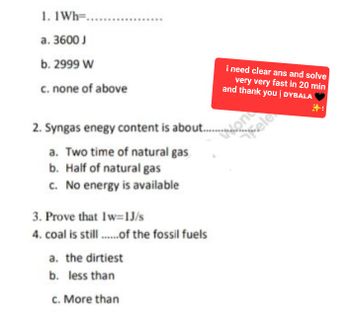
Introductory Circuit Analysis (13th Edition)
13th Edition
ISBN: 9780133923605
Author: Robert L. Boylestad
Publisher: PEARSON
expand_more
expand_more
format_list_bulleted
Concept explainers
Question

Transcribed Image Text:1. 1 Wh ........
a. 3600 J
b. 2999 W
c. none of above
2. Syngas enegy content is about.........on
a. Two time of natural gas
b. Half of natural gas
c. No energy is available
3. Prove that Iw=1J/s
4. coal is still........of the fossil fuels
i need clear ans and solve
very very fast in 20 min
and thank you | DYBALA
a. the dirtiest
b. less than
c. More than
Expert Solution
arrow_forward
Step 1
Power is rate of doing work.
Watt is unit of power.
Watt is equal to joule per second.
In electrical the rate at which electrical energy is transferred to electric circuit is power.
"Since you have asked multiple questions, we will solve the first question for you. If you want any specific question to be solved, the please specify the number of that question"
Step by stepSolved in 2 steps with 1 images

Knowledge Booster
Learn more about
Need a deep-dive on the concept behind this application? Look no further. Learn more about this topic, electrical-engineering and related others by exploring similar questions and additional content below.Similar questions
- The diode shown in Figure T9.2 is ideal. Determine the state of the diode and the values of vx and ix.arrow_forwardGive the suitable solution for the following The non-conventional sources of energy are........ The diesel power station cannot be located at any place (T or F) The d.c resistance of various types of conductors at specified temperature (T) is found by...... The self-GMD of a conductor depends upon the ...... ...... and ..................of the conductor The voltage drop is increased if the length of transmission line is increased (T or F) The skin effect depends upon the.............. ........ and ********* , and..... …........arrow_forwardSpecify the LM-series linear regulator required to regulate a fixed voltage of -19 V. Please write the numbers only in the answer field: i.e. for LM1234, you would write 1234 in the answer field.arrow_forward
- What is the second equation?arrow_forwardIdentify the characteristics of AC and DC voltage. Runs at a higher temperature Answer 1Choose...DCAC More dangerous to transfer Answer 2Choose...DCAC Easy to produce Answer 3Choose...DCAC Easier to transform voltages Answer 4Choose...DCAC Voltage remains at a constant value Answer 5Choose...DCAC Cheaper to producearrow_forward
arrow_back_ios
arrow_forward_ios
Recommended textbooks for you
 Introductory Circuit Analysis (13th Edition)Electrical EngineeringISBN:9780133923605Author:Robert L. BoylestadPublisher:PEARSON
Introductory Circuit Analysis (13th Edition)Electrical EngineeringISBN:9780133923605Author:Robert L. BoylestadPublisher:PEARSON Delmar's Standard Textbook Of ElectricityElectrical EngineeringISBN:9781337900348Author:Stephen L. HermanPublisher:Cengage Learning
Delmar's Standard Textbook Of ElectricityElectrical EngineeringISBN:9781337900348Author:Stephen L. HermanPublisher:Cengage Learning Programmable Logic ControllersElectrical EngineeringISBN:9780073373843Author:Frank D. PetruzellaPublisher:McGraw-Hill Education
Programmable Logic ControllersElectrical EngineeringISBN:9780073373843Author:Frank D. PetruzellaPublisher:McGraw-Hill Education Fundamentals of Electric CircuitsElectrical EngineeringISBN:9780078028229Author:Charles K Alexander, Matthew SadikuPublisher:McGraw-Hill Education
Fundamentals of Electric CircuitsElectrical EngineeringISBN:9780078028229Author:Charles K Alexander, Matthew SadikuPublisher:McGraw-Hill Education Electric Circuits. (11th Edition)Electrical EngineeringISBN:9780134746968Author:James W. Nilsson, Susan RiedelPublisher:PEARSON
Electric Circuits. (11th Edition)Electrical EngineeringISBN:9780134746968Author:James W. Nilsson, Susan RiedelPublisher:PEARSON Engineering ElectromagneticsElectrical EngineeringISBN:9780078028151Author:Hayt, William H. (william Hart), Jr, BUCK, John A.Publisher:Mcgraw-hill Education,
Engineering ElectromagneticsElectrical EngineeringISBN:9780078028151Author:Hayt, William H. (william Hart), Jr, BUCK, John A.Publisher:Mcgraw-hill Education,

Introductory Circuit Analysis (13th Edition)
Electrical Engineering
ISBN:9780133923605
Author:Robert L. Boylestad
Publisher:PEARSON

Delmar's Standard Textbook Of Electricity
Electrical Engineering
ISBN:9781337900348
Author:Stephen L. Herman
Publisher:Cengage Learning

Programmable Logic Controllers
Electrical Engineering
ISBN:9780073373843
Author:Frank D. Petruzella
Publisher:McGraw-Hill Education

Fundamentals of Electric Circuits
Electrical Engineering
ISBN:9780078028229
Author:Charles K Alexander, Matthew Sadiku
Publisher:McGraw-Hill Education

Electric Circuits. (11th Edition)
Electrical Engineering
ISBN:9780134746968
Author:James W. Nilsson, Susan Riedel
Publisher:PEARSON

Engineering Electromagnetics
Electrical Engineering
ISBN:9780078028151
Author:Hayt, William H. (william Hart), Jr, BUCK, John A.
Publisher:Mcgraw-hill Education,